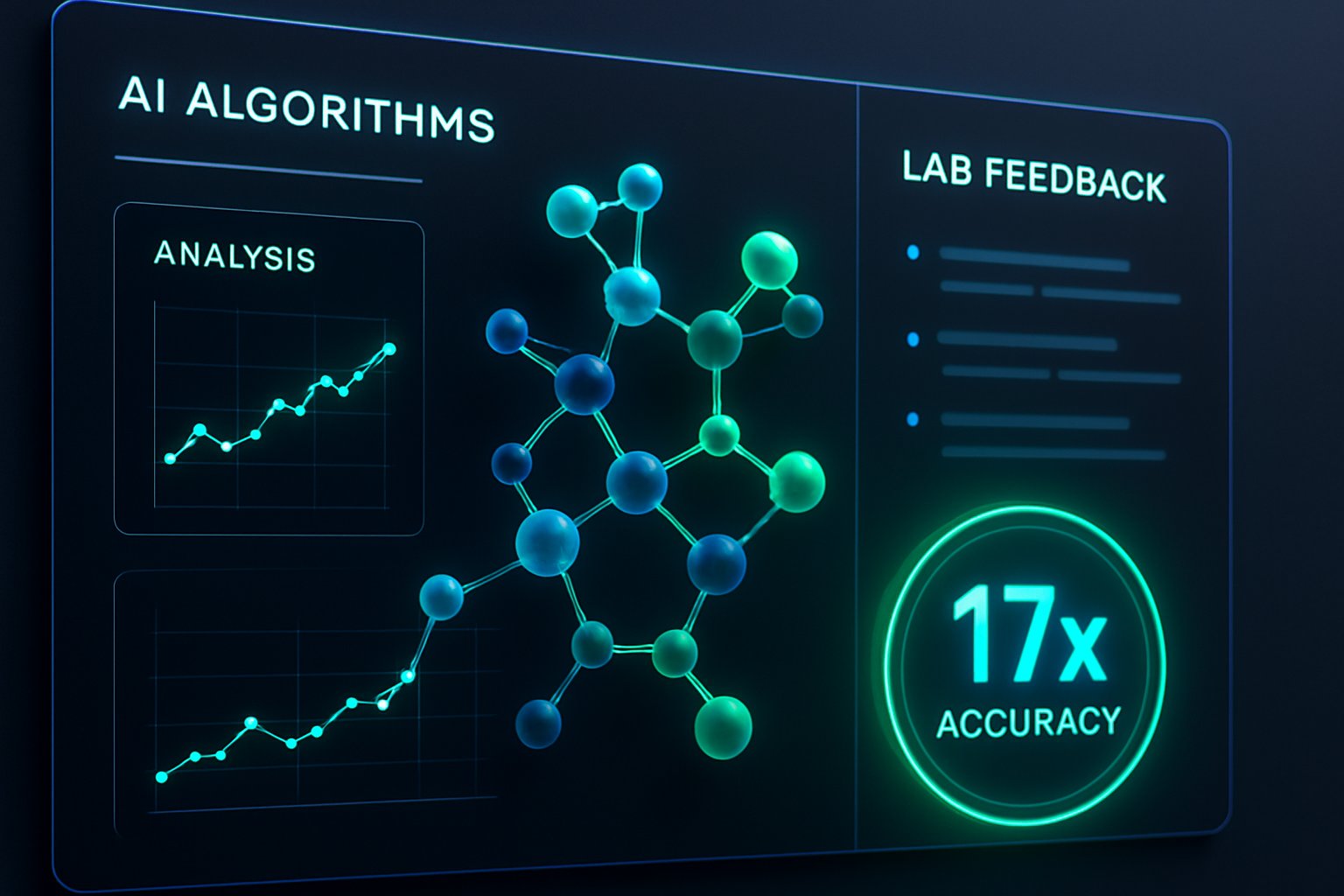
AI CERTS
18 hours ago
AI Drug Discovery: DrugReflector Achieves 17× Accuracy Lift
In contrast, conventional high-throughput screens test thousands or millions of compounds blindly. DrugReflector instead ranks about one hundred molecules based on gene expression signatures. Therefore, experimental burden drops while signal quality rises. Analysts cite a reported 17x accuracy improvement compared with random screening benchmarks.
DrugReflector Origins In Depth
The idea behind DrugReflector emerged inside MIT’s Shalek Lab during multi-omic hematology projects. Researchers confronted exploding single-cell datasets that conventional analytics could not digest. Consequently, they built a deep-learning pipeline trained on 9,600 compound perturbations across 50 cell types. Early prototypes foreshadowed a lab feedback AI workflow that would soon drive accuracy leaps.

MIT DrugReflector gained momentum after joint meetings with biotech partner Cellarity. Moreover, Cellarity contributed a single-cell perturbation atlas containing 1.26 million cells. The data enabled cross-cell transfer learning essential for generalizable predictions.
These origins highlight collaboration between academia and industry. Meanwhile, the workflow mechanics reveal why the model learns so quickly.
Active Learning Workflow Details
In AI drug discovery, DrugReflector follows an active learning cycle with four precise steps. First, algorithms rank compounds that could nudge diseased cells toward healthy states. Second, researchers test roughly 100 prioritized hits in focused phenotypic assays. Third, transcriptomic readouts flow back into the network, creating true lab feedback AI refinement.
Finally, the retrained model proposes a sharper list for the next experimental round. Therefore, each loop reduces uncertainty while conserving reagents and time. Hongkui Deng called the setup a “smart screening system that learns from its own experiments.”
In contrast, historical high-throughput screens require brute-force enumeration of chemical libraries. Moreover, they seldom integrate fresh data mid-campaign. DrugReflector’s loop marks a paradigm shift; next we quantify the performance gains.
Performance Metrics Fully Unpacked
The Science paper supplies headline numbers that caught industry attention. Across two hematology campaigns, DrugReflector achieved a 13–17× phenotypic hit-rate lift. Analysts refer to this as the celebrated 17x accuracy improvement figure. Adding a second lab feedback AI iteration roughly doubled success again.
- Training data: 9,600 compounds over 50 cell types.
- Experimental set: 107 model-selected molecules tested in specialized assays.
- Hit-rate uplift: 13–17× versus random selection, verified across duplicates.
- Dataset release: 1.26 million single cells enabling community benchmarking.
Such statistics are rare in AI drug discovery, where benchmarking often lacks transparency. Moreover, the study shares raw matrices and code, supporting reproducibility claims. Nature commentators praised the transparency yet urged multi-lab validation. MIT DrugReflector now appears on GitHub under a permissive license. Those numbers excite investors; consequently, we evaluate operational advantages next.
Benefits For Pharma Teams
The foremost benefit is efficiency. Al-Lazikani noted teams could screen hundreds instead of millions of molecules. Therefore, direct reagent savings align with mounting budget pressures in pharmaceutical AI programs. Time reductions also shorten decision cycles and free capacity for orthogonal assays.
Moreover, transcriptomic signatures reveal mechanism hints earlier than phenotype alone. Consequently, medicinal chemists can prioritize series rationally and avoid dead ends. Open datasets further accelerate benchmarking across competing pharmaceutical AI groups.
- Lower screening costs by double-digit percentages.
- Faster iteration through integrated lab feedback AI loops.
- Improved organisational learning via shared multi-omic repositories.
For AI drug discovery leaders, these gains translate directly to budget justification. Nevertheless, strategic adoption requires understanding current boundaries. The next section outlines key risks and caveats.
Known Limits And Risks
DrugReflector cannot yet predict effects for truly novel chemical scaffolds outside its training set. Hongkui Deng emphasized this chemical space limitation during post-publication interviews. Additionally, phenotypic accuracy does not guarantee downstream safety or pharmacokinetics. Consequently, traditional ADME and toxicity workflows remain indispensable.
Conflict-of-interest disclosures also deserve scrutiny because several authors consult for Cellarity. Nevertheless, peer review and data sharing partially mitigate bias concerns. Industry veterans therefore await independent replication before overhauling pipeline strategies. External replication across other AI drug discovery programs remains a priority.
These caveats temper enthusiasm while encouraging rigorous validation. Meanwhile, competitive context offers clues about future evolution.
Industry Context And Future
AI drug discovery now features many modality combinations. In contrast, DrugReflector centers on transcriptomics rather than purely structural learning. Global investments in AI drug discovery exceeded ten billion dollars last year. Insitro, Recursion, and BenevolentAI pursue related multimodal or pharmaceutical AI pipelines. However, few rivals publish 17x accuracy improvement metrics validated by peer reviewers.
Furthermore, MIT DrugReflector benefits from public datasets that spur community innovation. Regulatory agencies also track these trends to anticipate evidence standards for AI-guided submissions. Subsequently, we expect formal guidelines around data provenance and lab feedback AI cycles.
The converging ecosystem signals rising demand for specialized skills. Therefore, professionals must continually upskill to stay relevant.
Skills And Next Steps
Technical leaders require fluency in omics analytics, model monitoring, and experimental design. Moreover, the market values verified credentials that attest to these competencies. Professionals can enhance their expertise with the AI Healthcare Specialist™ certification. Consequently, certified practitioners often bridge communication gaps between data scientists and wet-lab biologists.
Additionally, familiarity with MIT DrugReflector code repositories offers hands-on insight into active learning engineering. Analysts should replicate sample pipelines using the released 1.26-million-cell dataset. Meanwhile, networking within pharmaceutical AI forums accelerates knowledge exchange and hiring prospects.
These steps cultivate a workforce ready to exploit AI drug discovery advances responsibly. Finally, we recap major insights and action items.
DrugReflector exemplifies how transcriptomic models and lab feedback AI loops refashion early pharmacology. The framework yielded a verified 17x accuracy improvement, saving time and resources. Moreover, public datasets and a transparent Science paper invite replication and refinement. Nevertheless, chemical space limits and clinical unknowns counsel cautious optimism. Consequently, teams adopting AI drug discovery must pair algorithms with rigorous wet-lab validation. Professionals attentive to skills, certifications, and open data will thrive in this evolving field. Explore the linked certification to position yourself at the forefront of pharmaceutical AI disruption.



